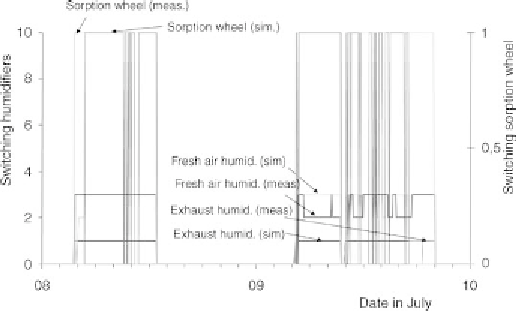Environmental Engineering Reference
In-Depth Information
Figure 5.40
Measured and simulated switching times of the humidifiers and the sorption rotor for 2
days in July
are slightly longer than the model calculations. The time discrepancy is especially
noticeable in the morning and evening, when the sorption wheel starts about 1 hour
earlier and stops up to 3 hours later than the simulated controller. During this time
period, free cooling is sufficient to provide the required cooling power.
The main difference between real operation and simulated operation was the ad-
ditional auxiliary heating demand: in real operation, regeneration operation nearly
always meant auxiliary power consumption, whereas in the simulated process, the
temperature levels of the collectors and preheated air were sufficient to cover the
cooling load. For example, on 3 days from 8 to 10 July the auxiliary heating was on
during the complete day period, whereas in the simulation model, only about 1 hour
of auxiliary heating was necessary (see Figure 5.41). The problem in the implemented
control strategy is that regeneration always means a fixed and rather high temperature
level, whereas often lower temperature levels would be sufficient.
As a consequence, the simulation model applied to the month of July resulted
in 90% less auxiliary heating energy demand! Some 42 kWh auxiliary heating was
obtained from the simulation, whereas the measured auxiliary heating consumption
was 3900 kWh.
Using the full simulation model, some parameter studies could be carried out.
Doubling the collector size to 200m
2
increases the collector thermal energy production
by 70% and reduces the auxiliary energy production by 25%. The specific collector
yield drops slightly by 10%. As the specific energy production of the solar thermal
collector is quite low anyhow, the amount of auxiliary energy reduction would never
justify the additional investment costs for the collector field. Only significantly longer
operating times for the regeneration mode, for example for air drying or other heating
purposes, could economically justify higher collector surface areas.

Search WWH ::

Custom Search